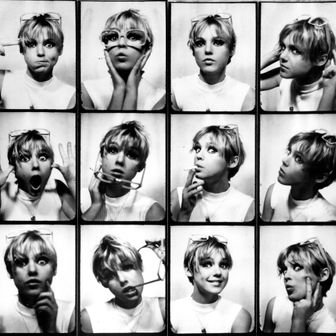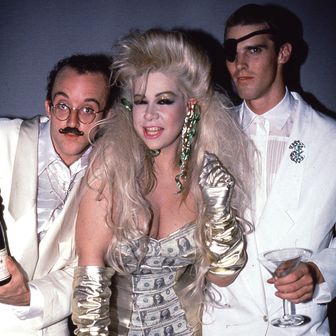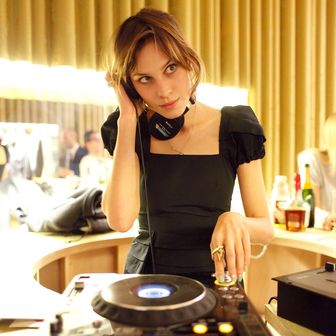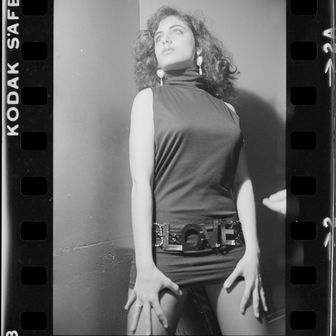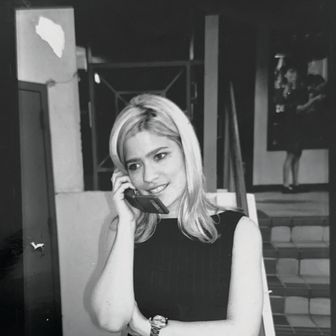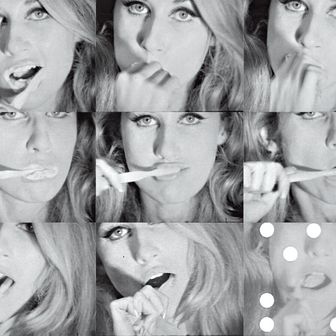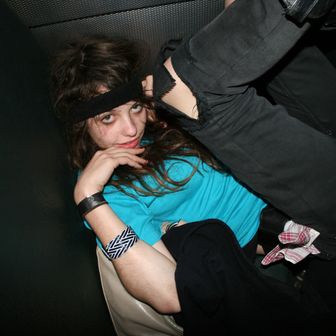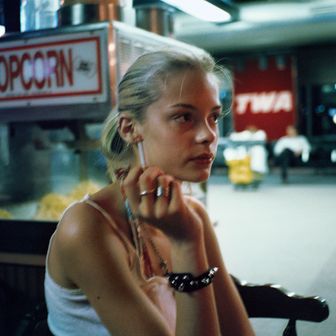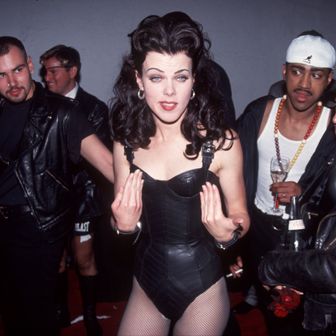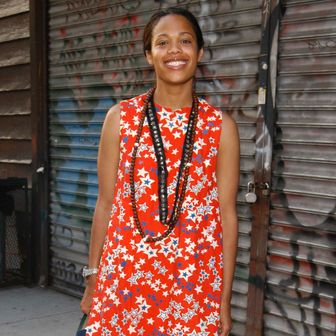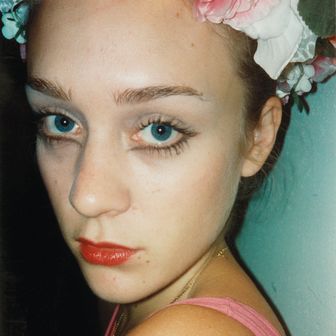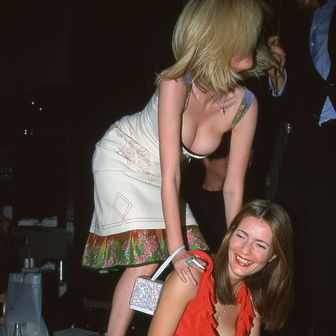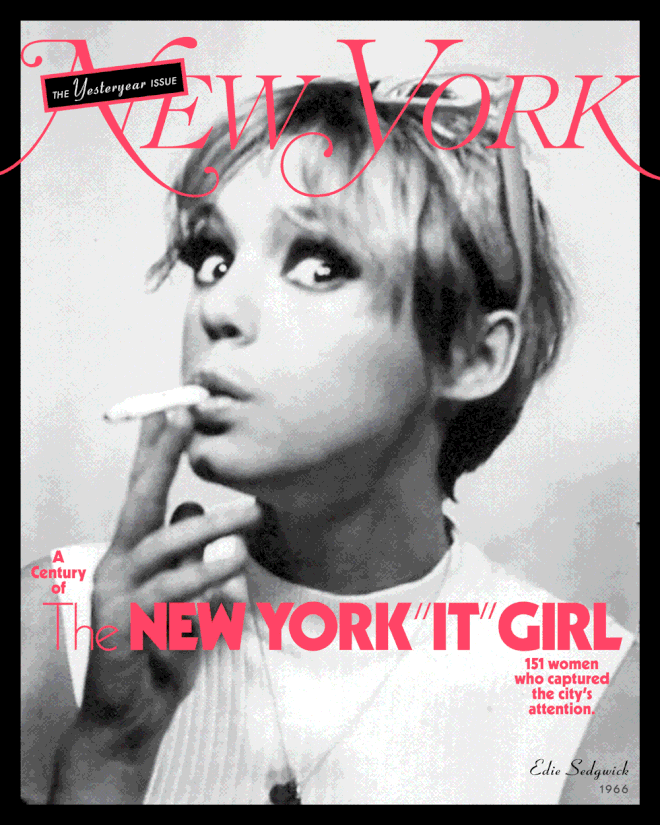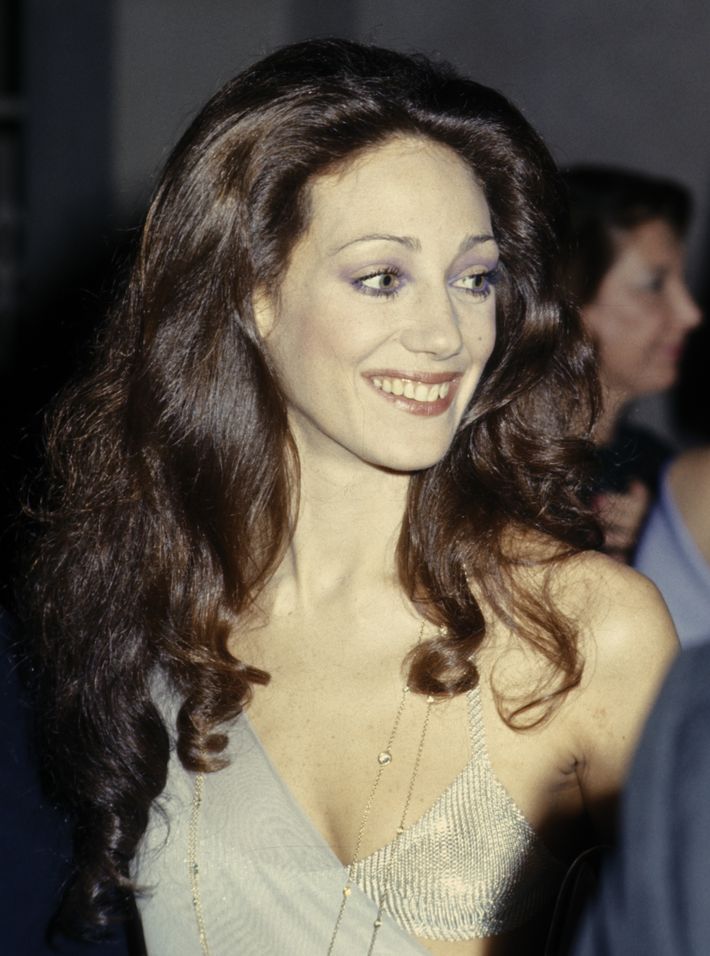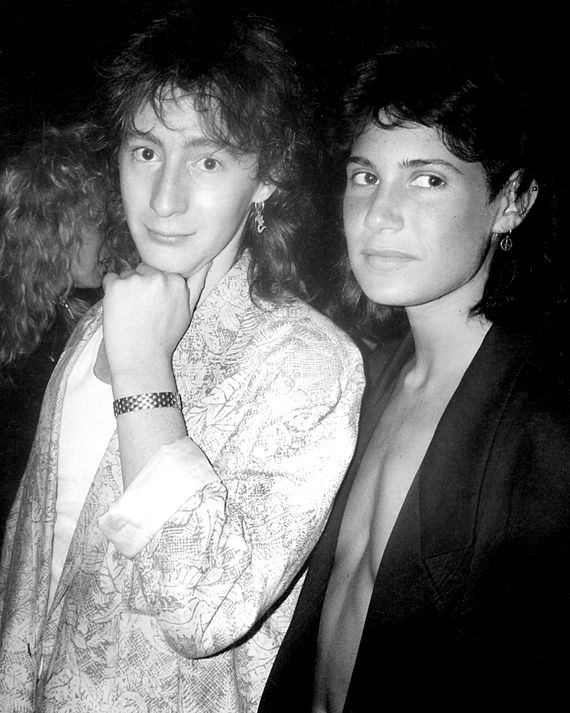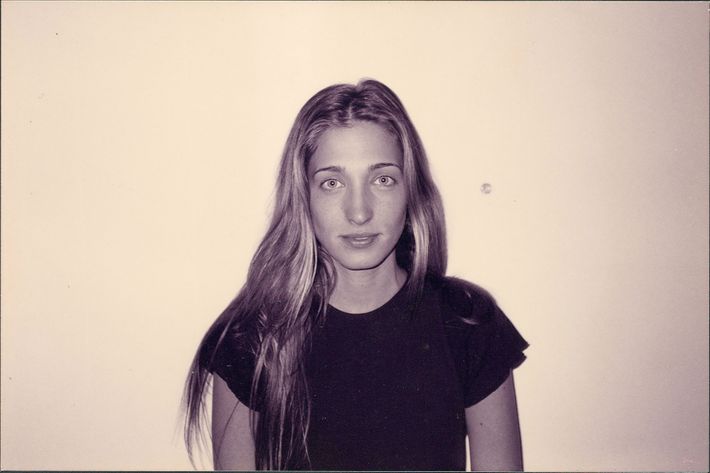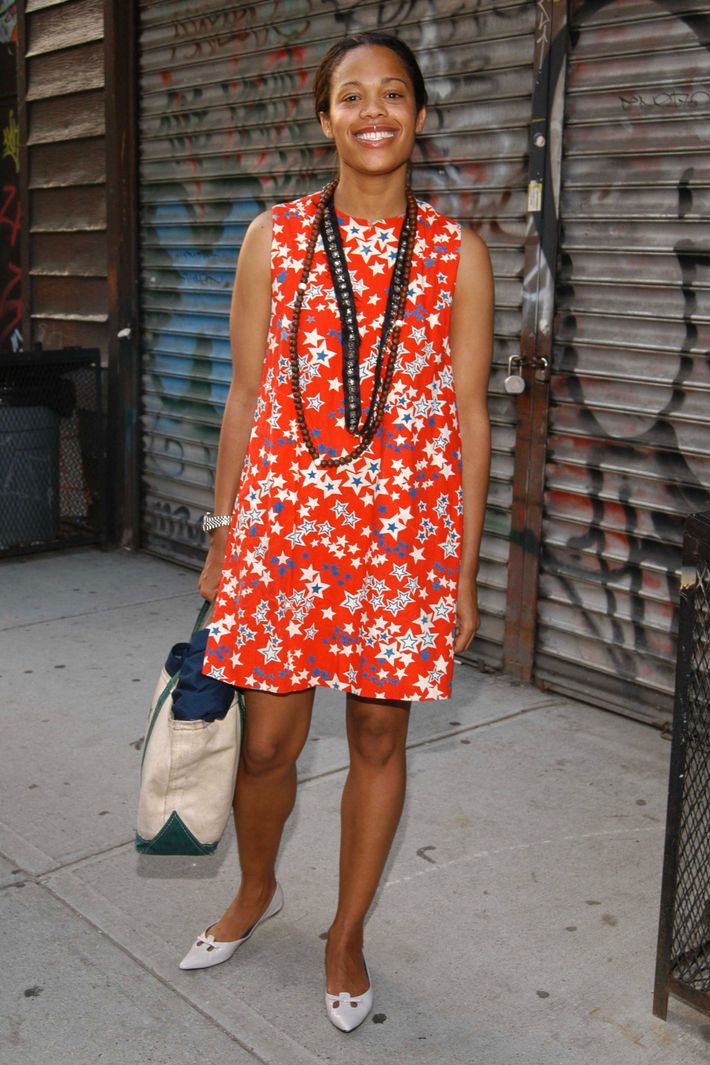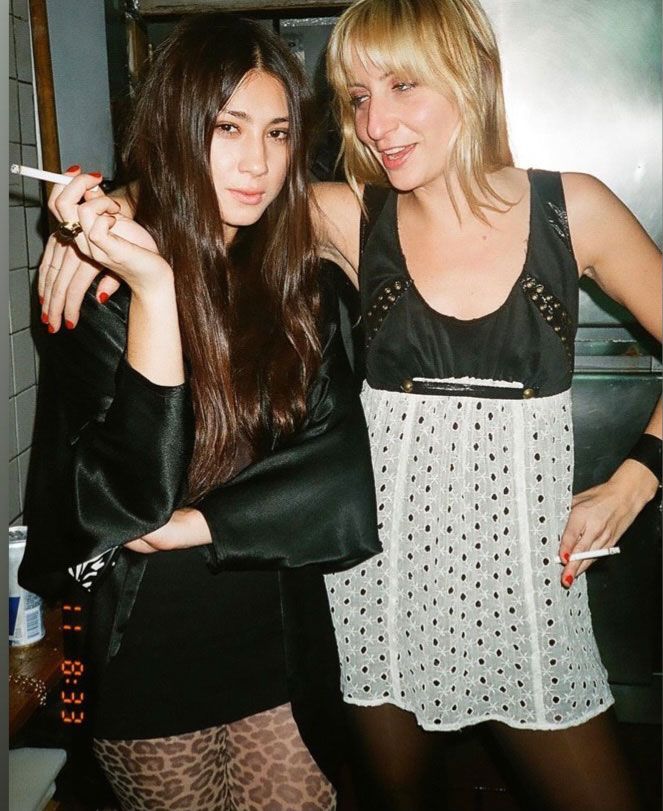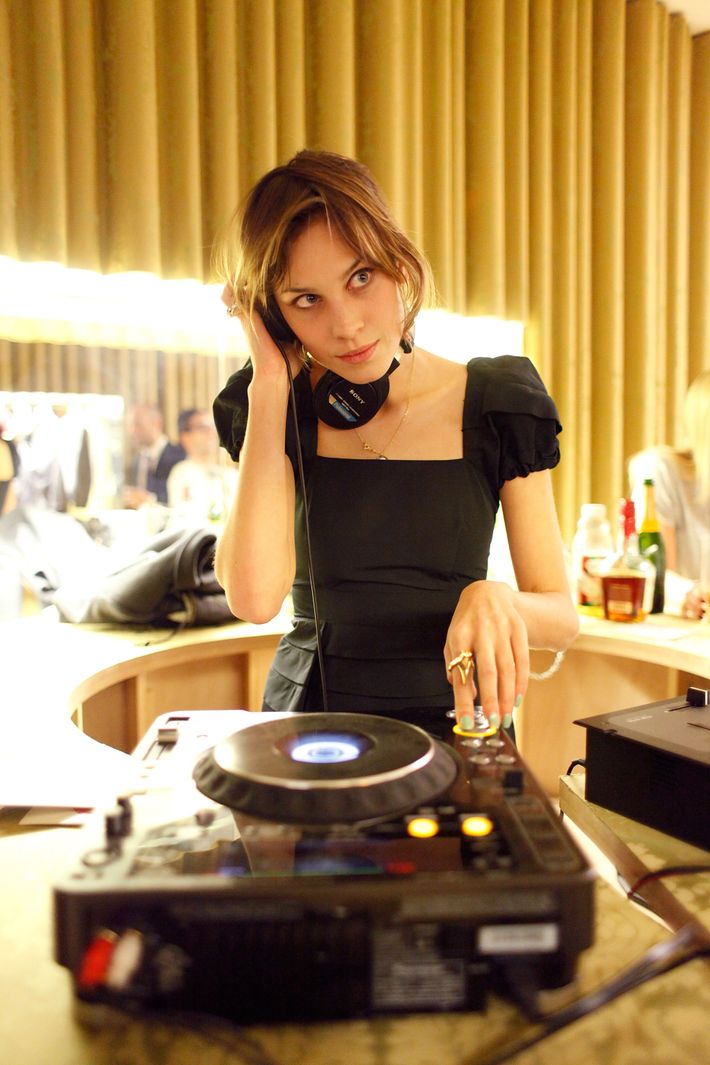On August 22, 1985, a woman with a She-Ra mane and a latex dress appeared on Late Night With David Letterman. Letterman, still spiky in his salad days at NBC, was charmed but befuddled as he interviewed her. Unlike many of his guests that season — Johnny Cash, Teri Garr, Eddie Murphy — Dianne Brill’s qualification for the spotlight was hard to describe. True, her photograph was on the cover of that morning’s New York Post; Letterman had a copy. But still, he seemed unsure who she was. Or, as he was compelled to ask her about her front-page placement, “Why are you there?”
Cover Story
Letterman acknowledged that Brill was “known in New York as ‘Queen of the Night’” — what had been called, and would be called again, many times, an “It” girl. New York mints these women: famous for being out, famous for being young, famous for being fun, famous for being famous. Letterman was still confused. “Uh, Dianne, tell me about the Queen of the Night,” he said. “How do you get to be? Is this an elected position, you were appointed by the mayor, or what happens?”
“As a matter of fact, I met Mayor Koch,” Brill answered gamely before venturing an explanation of her title. “I think what it means is that I’m a cheerleader. I’m a downtown, uptown, midtown cheerleader. I go everywhere.” And then Brill laid out, in essence, the rules of engagement: You go out every night. The best time to show up is the peak of the party. The peak of the party is a mood. The question is not always when to come but when to leave — and that time is once you’ve said “hello” to everyone. You exit discreetly. “And then,” Brill said, “the party crashes. And they think obviously you’re the one who made the party because all of a sudden, when you leave, the party’s down.”
All of a sudden, when you leave, the party’s down. There, in a koan and a credo, is as good a working definition of “It” as we are likely to encounter.
At the risk of saying more and understanding less, let’s add a few details. “It” girls are primarily young — not exclusively; you could make a decent case for Iris Apfel’s having become an octogenarian “It” girl in the mid-aughts — but going out voraciously is a prime determinant of “It,” and a youthful energy helps. So does a sense of style, especially one unto yourself. A job is not a requirement. It’s more “It” to have either two jobs or no jobs; a bit of mystery is very “It,” and if no one can quite figure out what you do, so much the better. “People never know how to describe me — what I am,” Sally Randall, a Palladium doorgirl and post-Brill ’80s “It” girl, told this magazine in 1985. “They say, ‘You have to see it.’”
The “It” girl has been defined not by herself — to seek “It,” at least publicly, is not very “It” — but by her chroniclers: magazine writers, newspaper columnists, photographers. She is someone “everyone is drawn to — someone people want to gossip about,” says Patrick McMullan, the nightlife photographer who for nearly 40 years has been a fixture of the New York scene.
“An ‘It’ girl is an amateur in all things,” says the novelist Jay McInerney, who wrote one of the foundational texts of ’90s “It,” a New Yorker profile of a 19-year-old waif named Chloë Sevigny. “You know, a sort of supreme dilettante.” At the time, Sevigny was a supreme dilettante: She’d appeared in a Sonic Youth music video, walked Kim Gordon’s X-girl show, and was filming Kids with Larry Clark and Harmony Korine. “I honestly never thought she would become an actual actress,” McInerney says. “She just seemed to exist in the moment and to not have any grand ambitions and yet to have so much style and so much charisma and so much influence.” Although she remains eternally cool, Sevigny at this point is too professionally established and too well known to count as an “It” girl anymore. Contrary to popular use, “It” requires not only some degree of fame but also the right leavening of obscurity. An undeniable celebrity is not an “It” girl. Read the full investigation ➼
‘It’ Girls Through the Decades
The ’60s
You could find the “It” girls at the Peppermint Lounge as teenagers before they moved on to the Scene a couple of years later, shopping for minidresses at Paraphernalia and Betsey Bunky Nini, getting up with Obetrol and down with Valium, rooming at the Barbizon Hotel, popping in to see Andy Warhol at the Factory on 47th Street, peering at the vintage racks of Limbo, buying their makeup at Cambridge Chemists, attending Be-Ins in Central Park, stopping for a 2 a.m. omelet or shrimp-and-lobster salad at the Brasserie on Park Avenue.
.
Jane Holzer
The original Warhol girl doesn’t think that much about her time in the limelight.
By Bridget Read
Jane Holzer’s calling card was her hair: a towering blonde bouffant, teased and flipped over like a cresting wave, that Tom Wolfe would dub her “huge hairy corona” when he anointed her the “Girl of the Year” in 1964. At first, she was mostly another society girl: a 23-year-old Palm Beach heiress and Park Avenue housewife who had gotten a taste of fame when David Bailey took her photo for British Vogue in 1963. Around that time, Holzer was walking down Lexington Avenue when she ran into Andy Warhol, who asked her to be in his movies. With that, Baby Jane, as she was known, became Warhol’s first superstar, her corona bobbing to every concert, soirée, and shindig that mattered. She was a blonde flag planted on the dance floor signifying that whatever was happening was happening: the first “It” girl of the modern age.
Today, at age 82, Holzer lives full time in Palm Beach. The daughter of a real-estate investor — and the ex-wife of another — she is busy with the family business, managing residential and commercial properties across the county. Last fall, she razed a 4,400-square-foot South Ocean Boulevard mansion to build her own 11,000-square-foot one; the designs include a gallery for her large contemporary and Pop art collection, which, of course, includes many Warhols. Looking back, she considers her role in this revolutionary cultural moment as just another Happening: accidental, cool, not something to overthink. “It’s either constipated or not,” Holzer told me when I asked her how she decides on a scene to join, a club to enter, a dress to wear, a painting to buy. “And I very often choose ‘not.’” Continue reading ➼
.
Ali MacGraw
In the early ’60s, the actress was Diana Vreeland’s assistant-about-town.
“My closest friend, Barbara Nessim — we met in 1960 when she lived with Gloria Steinem. And there was a moment when she was spending all of her time with her boyfriend, and I was out looking for work. And she said, ‘Why don’t you take my bed?’ So me and my Scottie dog and a single suitcase arrived at Gloria’s apartment, and I got to watch early Gloria, which was really something.
And when I eventually got my first job as Diana Vreeland’s assistant, it was Anne Hathaway’s job in The Devil Wears Prada. But it was pre–shiny black limos taking you around to do your work, pre–magazine closet to borrow from, pre–being invited to Paris. I got $54 a week for it. I went to Mrs. Vreeland’s house nearly every morning and took her portfolio the ten-block walk back to the then–Harper’s Bazaar building on Madison Avenue. I had friends who were artists. I had friends who were models, interesting models, people that had an interior life too, and some editors. It just was high energy. I mean I did have a Studio 54 phase, and probably I was one of the lucky ones because I was recognizable, so I didn’t have to stand in line crying because I couldn’t get in. It was the kind of time that’s absolutely impossible for anybody who didn’t live it to imagine ever happened. To see everything, be everywhere — you know, it was astonishing. I mean I had no money. I remember at the end of the week coming home and saying, ‘Let’s see, what are we gonna have for dinner tonight? Should we have scrambled eggs and flowers? Or shall I get a proper dinner? I think we’ll have scrambled eggs and flowers.’”
The ’70s
You could find the “It” girls visiting Halston at his salon in Olympic Tower and his house on East 63rd Street, shopping at the Biba counter at Bloomingdale’s and the Courrèges store on 57th, after hours at Maxwell’s Plum and Max’s Kansas City or coupled up on Fire Island or at a New York Dolls show at the Mercer Arts Center, dancing at Studio 54 (or Xenon, if it was just too hard to get in that night), getting one of the dozen burgers served every night at Raoul’s, having lunch with their mothers at La Côte Basque or La Grenouille, where they discussed Fear of Flying.
.
Marisa Berenson
“In the wave of nostalgia that has grown out of the guilty aftertaste of the ’60s, society is spinning backward at a terrific rate. And Marisa is perfect to lead the retreat. Even the words her friends use to describe her are old-fashioned. ‘Marisa is always there, always the most beautiful and most beautifully dressed,’ says Paloma Picasso … ‘She is always charming and nice.’ Drugs ‘scare’ her. Liquor ‘doesn’t agree with her.’ And she doesn’t even drink wine. ‘I like nothing that leaves me out of control.’” — Steve Saler, “The Girl Who Has Everything Plus,” Newsweek, 1973
“I was born in New York but had spent my whole childhood in Europe. But I came back when I was 16, when my dad was dying of leukemia. One of the last times he ever went out, he took me to this ball, and Diana Vreeland was there. She had been a great friend of my grandmother’s, Elsa Schiaparelli, and I hadn’t seen her since I was 4 or 5, and she just looked at me and she said, “We have to photograph Marisa.” And that was it. All of a sudden, I found myself working nonstop for Vogue as a model and going to Europe and working with all of the great photographers — Penn, Avedon — and my whole life exploded. I was very existential as a child. I remember being in my room alone in Switzerland and thinking, What is my purpose here? Who is God? What am I doing on this planet? What is my destiny? Where am I going? I’ve always felt the purpose of my having a career as a model and then an actress was for me to sort of be a conduit for something bigger, you know? I was very lucky because I feel that I was protected in the sense that I was always searching for light, so I didn’t get caught up in the darkness of it, the decadence, even though I was right in the middle of everything that was going on. We were out every night at Studio 54, and I was working every day and traveling, but for some reason, I survived it all. I didn’t get caught up in the drugs and the promiscuity. I was meditating and drinking orange juice, and people would joke that I would eat lotus leaves because I went to an ashram in India. It was a fantastic time to be alive — and we were very much alive until, you know, unfortunately, some people weren’t. In 1973, I was on the cover of Newsweek as the queen of the scene — Saint Laurent at the time had baptized me as the ‘It’ girl of the ’70s. Quite honestly, I didn’t understand it. I mean, it is still a mystery to me. I think it’s probably a spark, something much deeper than what’s on the outside, something that comes from within that just makes you vibrate on a different level.”
.
Edwige Belmore
Maripol remembers the six-foot-tall Parisian “Queen of Punk.”
“It starts in Paris before I even moved here. So we’re talking 1975, and Serge Kruger, who had a line of jeans and had the best club in Paris back then, basically was having a private party at his house, and that’s where I met Edwige. She was about 16 or 17 and extremely shy, but she was fascinating to me. This statuesque beauty, who was wearing these kind of Bermuda shorts, had this short haircut — I was intrigued. She became the doorgirl of Les Bain Douches and was modeling for Thierry Mugler and Gaultier and was at that point an “It” girl in Paris, hanging out with Loulou de la Falaise and Yves Saint Laurent. Me and my boyfriend Edo Bertoglio left for New York in 1976, and Edwige ended up coming to New York and crashed at our place before finding her own apartment. To make a long story short, she became known as the ‘Queen of Punk.’ She was tattooed way before other people had tattoos, she was an out and very proud lesbian before other people were, she had a motorcycle, she dyed her hair blonde. She was tough. She was this singer; she threw parties; she was an artist; she was going out for a long time with Lovey Moreno, a top model at the time. Andy Warhol loved her. I think he was impressed by her size.
Edwige had the tendency to cut herself. One day, at this party at Victor Hugo’s house, I saw her playing with her arm, and I didn’t know what was going on, so I took a fucking Polaroid of her, but then I saw she had blood on her hand. I had to be the nurse; I went to the hospital with her. Edwige needed attention, and a lot of times, if you need attention, it means you need love. She always said it was her birthday even when it wasn’t. She was very much into being famous — if only the money would have come … I think some of that depressed her later on in life and was one of the reasons she turned to drugs. Edwige was my dance partner. We danced to rock and roll together, we danced at Studio 54 together, we’d get carried away — oh, I miss that.”
.
Diane von Furstenberg
In conversation with Mickey Boardman, editor-at-large of Paper magazine.
“Her mouth down-curved into a posture of terminal boredom, she radiates contempt and a peculiar sensuality that mocks men rather than lures them.” — Linda Francke, “The Couple That Has Everything. Is Everything Enough?” New York Magazine, 1973
Mickey Boardman: So we’re talking about “It” girls.
Diane von Furstenberg: I don’t think I was an “It” girl because I married so young — I mean, 22. By the time I was 24, I had two kids. I had a business. But there’s no question that Egon and I were the “It” couple — that I can say.
MB: Of course.
DVF: Fifty years ago in February, Egon and I were on the cover of New York Magazine, and Egon talked about our open marriage. Because of that article, I realized that we couldn’t be a couple, so we separated, but we stayed best friends.
MB: Did you always want to move to New York?
DVF: New York was very appealing for us Europeans. When I first got here, Egon was the talk of the town because every girl wanted to marry him and become a princess. I arrived, so everybody would say, “Who is this girl?” The girls were pretending to be nice to me and taking me to lunch at La Caravelle, and the designers, the young designers, wanted to dress me. We got married, and we stayed here. But I don’t think I was ever an “It” girl. I was an “It” woman or an “It” couple.
MB: One of my favorite things you ever said was when you were young, you tried to look older, so that way, when you were older, people would say you looked exactly how you did when you were young.
DVF: I love age. When I turned 20, my mother said, “How does it feel?” I said, “I’ve been saying I was 20 for five years.” When I was growing up, I wanted to be in charge. Okay? I wanted to be a woman in charge. I became that because of a little dress.
MB: You spent a lot of time at Studio 54.
DVF: It was the best pickup place in the world. But I was not really somebody who stayed hours and hours and went downstairs and did drugs and things like that. I was already separated by then. I would have dinner with my mother and my children and then I would get dressed, take my car, and drive. Next to Studio 54, there was a parking garage, and I’d arrive by myself. And then you arrive and they give you a beer and Steve would give you a quaalude after you were in. But I am not a nightclub hag, you know? I would meet friends there, but the arrival, myself, in that long corridor with the disco music, Studio 54 was about that.
.
Grace Jones
Val LeGaspi on dressing her at Studio 54.
“My husband, Larry LeGaspi, designed this outfit for her performance — she was dressed up as Nefertiti. I remember her being carried out by half-naked musclemen. And at one point, a motorcycle came out. I mean, the crowd was crazy about her. It wasn’t straight-straight, and it wasn’t gay-gay. And everybody could be androgynous, and everybody could be who they were and dress as they wanted. She was a great symbol for that. They were dancing and screaming. It was very electric, very hot.”
.
Pat Cleveland
The trailblazing supermodel who made spaghetti with Halston.
“Remember that game tag? That’s what it feels like. Everybody running after you to touch you.
I was an art student, making clothes and dressing up and sneaking into the discos on the weekends. I went to the Cheetah, Le Club, the Peppermint Lounge — I looked kind of grown up and sophisticated, and the way I dressed was very voguish, so people probably thought I was 18, even though I was 14, 15 years old. I knew how to fake it. I used to go play cards with Omar Sharif and Yul Brynner. I was just a teenager and hanging out with them, Richard Harris, and, you know, the Kennedys. The person who discovered me was an English girl. I was pretty weird looking, so I guess her taste went down that road. Very skinny, like a giraffe wearing spats. I had on this outfit that I made. That day, the buses were on strike, so I had to take the subway, and she followed me — she was running after me and my girlfriend, and my girlfriend said, ‘Oh my God, is this lady gonna rob you? You better run.’ But I thought she looked nice, so I stopped. All these people were walking behind me. It was like dominoes — they all bumped into me. And she was out of breath. She said, ‘Oh, thank you. I’m so glad you stopped. I admire what you’re wearing.’ Then she pulled out this Vogue card.
By the time I was 16, I had been to the Ebony Fashion Fair and Muhammad Ali had asked my mother if he could marry me. He pursued me from one state to the next, and it was just not possible because, at that time, he was turning into this different person. He was no longer Cassius Clay. He was becoming Muhammad Ali. And he didn’t want me to wear miniskirts. So I figured, This is not gonna work for me.
I was 18 or 19 when I met Halston, but he remembered me from the Ebony Fashion Fair. He said, ‘You don’t remember me, but I came to see you in a show in 1966 in Chicago.’ My favorite times with him were so personal. On the weekends, I would go up to Montauk with him and Andy, and we would have such a ball. We’d sit on the floor and watch monster B-movies, like The Blob, and then we’d go in the kitchen and make spaghetti on the spaghetti machine. Nobody could cook. We’d be up in Montauk like, ‘Who can cook? Who can make sauce?’ And Victor Hugo could make the sauce. Halston gave these big parties with movie stars. He always cared for people, like Liza Minnelli and Elizabeth Taylor. These women were leaning on his shoulders not only to get beautified but for emotional support. And sometimes Halston would say to me, ‘Could you take Elizabeth into the bathroom and straighten her up a bit?’ And then I’d be in the bathroom with Elizabeth Taylor straightening her clothes up, and she’d be reciting “The Owl and the Pussy-Cat” to me.
A lot happens when you’re young and you’re dressed well and you look available. Once, I was sick in my room in England at the Portobello Hotel, and my friend said, ‘Mick Jagger is in the restaurant. You should go down there and say ‘hi.’ If you don’t go down there, I’m gonna kill you.’ I went down there, and he saw me. He said, ‘Come over here, sit with me, let’s eat together.’ Then Bianca showed. She was so pissed off and gave me the evil eye, and I was feeling tired and didn’t want to be there at all. I said, ‘Listen, you know, I’ll catch you later.’”
.
Bianca Jagger
Robin Platzer on photographing her 32nd birthday party, the first one ever thrown at Studio 54.
“I shot her birthday party just days after Studio 54 opened. And as my sister said — I have a twin, and we always went together there — “The only ones not famous in this room are you and I.” Everybody was famous: Jacqueline Bisset and Baryshnikov and obviously Mick Jagger and Halston and I don’t remember who else, but it was amazing that she could get that many famous people in one room dancing and having a good time. The horse was cool. It was the only time I saw a horse in that place.”
The ’80s
You could find the “It” girls dancing with Madonna at Danceteria before she got big, then sitting at the next table over from her at the Odeon a couple of years later; going to AREA and the Palladium and, before it went all bridge-and-tunnel, Limelight (but not the briefly reborn Studio 54); working out at the Vertical Club; hanging out at Elaine’s and Indochine; shopping at Charivari and the Antique Boutique; staying up with cocaine and coming down with Quaaludes; (barely) eating macrobiotically; ordering Absolut on the rocks; reading about themselves in Michael Musto’s column and Stephen Saban’s and Liz Smith’s after they turn up at the same East Village parties as Basquiat, Keith Haring, and (still) Andy Warhol.
.
Dianne Brill
“The lady in latex is Dianne Brill, a 26-year-old fashion designer who has become, seemingly overnight, First Citizen of Manhattan nightlife. If there’s an opening, a party, a lotto drawing, anything where cameras are clicking from Harlem to Tribeca, she is there. In an era when status is determined by visibility, her bursting hourglass figure is the highest profile in town. When she arrives, the party begins.” — David Hutchings, “No Double Exposure, That’s All Dianne Brill, the New Queen of the Night,” People, 1985.
“I don’t think they understood me in Tampa. I had a friend who knew someone who was in New York, and my friend said, ‘You know, just come up for a couple days.’ So this was 1980, and I was 19 or 20, and I took a giant body bag full of vintage clothing that I bought in Tampa, and I walked into Trash and Vaudeville and showed Ray some rock-and-roll buttons, and he bought everything in cash. Then I went into Patricia Field, because I’d seen an ad for Patricia Field in Interview magazine, and that was my lifeline. And she was, like, a hard-ass, and she was looking at me in my five-inch stilettos and a rubber dress and all that stuff, schlepping my body bags down the stairs and into the store, and she’s looking at this, that, and the other, and she took everything. So there I was with a pile of cash in my hand, and I thought, Okay, I’ll stay.
I always wanted to go out, but I didn’t know how. Then I met this guy, Giancarlo Bertoni. He was an anesthesiologist but also a dance-hall DJ, and he and his wife befriended me, and he took me to Danceteria for the first time. And also Mudd Club. As soon as I walked into that environment, it was immediate that there was this feeling of acceptance and belonging and a certain understanding. I never had to explain myself. And I felt people were very excited about meeting me, even though I was just the girl from somewhere else. I always looked good. Not in the sense of being a natural beauty; I just mean I always played with my look.
It was all Jayne Mansfield va-va-va-voom. Jayne Mansfield couldn’t wink, so she’d blink both of her eyes, and I was doing that for a while. I was trading in vintage clothing so I could buy things every day. For a few dollars, I’d buy a dress, and I’d buy several a day — throw one in at the dry cleaner, have it in a couple hours, and wear it that night; cut it, pull the sleeves down, tuck it in with some tape, put the corset on, and walk out the door. It was 1980, so Studio 54 was really kind of over. All that twittering cocaine ’70s stuff was done. Post-punk New Wave was really starting to grow in the clubs. I smiled. You know, this was not a time of smiling. It was, like, all about posing against the wall with a cigarette. And then there was me: super-happy to see you, like a puppy. The timing was good for that. I think New York was ready for that.
.
Connie Fleming
The East Village drag star (a.k.a. Connie Girl) turned Mugler model turned legendary doorwoman — who still runs a tight ship at the Standard.
“In 1984, I had just graduated from high school, and I found a job at Antique Boutique, which is where I met David Glamamore. We were both kids running around the city, trying to make our way. Ciao! Manhattan had come out in paperback, and we were all wrapped up in that sort of Andy Warhol–’60s-Factory moment. One night after work, before we went out, David said, “Oh, let’s go to Boy Bar for a drink.” And that night, I met Matthew Kasten. We started to talk, and it was really an aligning of stars. He was there meeting with the owner of Boy Bar to start doing drag shows, and he was telling me about them. And before you know it, I blinked and I could feel Matthew’s hands pushing me onstage at Boy Bar for my first night. And I was so super-nervous. He literally pushed me on. And when I got to the stage, the lights blinded me, and it sort of clicked in my mind. I was like, Oh, I can’t see anybody. I can’t see anything. Maybe I could do this. And, again, I trusted myself and cast off all of the doubt, and before you knew it, we were famous below 14th Street. That’s when Connie Girl was born. I started working at Boy Bar when I was in my late teens, and for the first couple of years there, we’d throw our fake 23rd birthdays — and then we’d count backward. Those first years at Boy Bar, I got to know my community: Marsha P. Johnson, Sylvia Rivera, whom you would see and you’d be like, Well, who’s the crazy lady, right? And then they’d show you an article or they’d tell you about her. There was International Chrysis, muse to Salvador Dalí and a great champion for me and a guide as a trans woman. But it was weird at that time; a lot of my heroes, whom I really grew up loving, were going by the day because the plague was so rampant. You’d be like, Oh, I’m going to meet this person tonight. But then you’d find out that they had passed away.
I then decided to step away to put the time in, and the energy in, for my gender transition. Which was a great lesson that International Chrysis taught me — that at some point in time, you’re going to have to make your own world and carve that out for yourself and make it for you. Because the outside world doesn’t have a real understanding of us. You have to make it be what works for you.”
.
Elizabeth Saltzman
The Upper East Sider who came downtown.
“The amount of times I’ve been offered a book deal, it’s hysterical. It’s just like, You don’t understand; my memory is shot. I grew up in Manhattan and I would borrow my mother’s clothes. And I remember borrowing this blue satin dress, and I got this blue wig and put it on and walked into the Met Gala like I belonged — and I don’t believe I had hit 16 yet. And I just got myself in there and saw my mom [Saks fashion director Ellin Saltzman] and dad on the dance floor and pivoted and just went in a different direction because I knew that dress had been made for her. But where it started for me was at Parachute. I was going to go to college and then I didn’t want to go to college once I got there, so I started working there as a salesgirl. It was an amazing crew of people, if you think about who came out of there. James Jebbia from Supreme, Ruben Toledo, Wilfredo Rosado. Wilfredo was my roommate in an apartment on the Bowery. He had worked at the Factory with Andy Warhol. That moment was about Paradise Garage and AREA. I loved AREA — that was just the greatest place ever. I got noticed because of something: I didn’t have talent like the other people had, but I could provide happiness; I had fun.”
.
Cornelia Guest
“She spent 1982 as a debutante, and all year long the New York gossip journalists mentioned her in print, often dusting off a quaint epithet: deb of the year. ‘I don’t get tired of it,’ she says, having finished her eggs and her Tab and three more cigarettes cadged from a waiter.” — Kurt Andersen, “A Deb Sings at Xenon,” Time, 1983.
“At my debutante ball at the Waldorf-Astoria, my brother escorted me because my father had just died. After you come out, you do your curtsy and then they have you sit in, like, a star formation with a candle. And my mother [ C. Z. Guest] comes up and says, “Get off the floor. You are not sitting in that beautiful dress” — Carolina Herrera made it — “Get up.” And we stayed for another ten minutes and then we went to Studio 54. Being named “Deb of the Year,” I just thought, Whatever. I mean, I thought it was fun, but it wasn’t a big deal. All I cared about were my horses and boys, going out and dancing on a speaker all night. That was the big thing: if you got to dance on a speaker. That was the cool stuff.
I ended up moving to California to become an actress. It was difficult to come to California and be known as a socialite, even though I’d been studying at the Strasberg Institute. And I’m so not a socialite. I mean, I’m so not. I was when I was a teenager, but I was a normal teenager going to abnormal nightclubs. But I wasn’t doing it 24/7. I was photographed, so it might’ve seemed like I was going out and partying more than I really did. And now, my God, my social life is so different.
I’m very happy with my life now. I’ll give you a typical example. I have a place in Texas now. I rescued a tom turkey — his name is Phillip — a couple months ago. I have some chickens, and Phillip needed a mate because he was trying to mate with the poor little chickens, so a female turkey named Elizabeth came the other day, and she’s just beautiful. So I was out playing with her this morning. And then my chicken Henrietta had little babies. She has four chicks. She was sitting on her eggs, and I’m so excited, so I was out visiting with her. And then, after that, I worked out this morning. I had an audition. I do Pilates with Michael Podwal, whom I’ve done Pilates with for 20 years. And then I pruned all the hydrangeas.”
.
Cookie Mueller
John Waters remembers the Baltimore-bred writer–actor–designer–director–barmaid–leg model–drug dealer–health columnist.
“There used to be a term, slum goddess, which was actually a nice term. Cookie was proudly a slum goddess, but she was glamorous. She was also a hippie who was influenced by Janis Joplin. Then also, she was like a Baltimore bad girl. She put those styles together, so we instantly bonded. I remember sunbathing, she would just trim her pubes and families would start screaming and stuff. She never held back much. She just felt like, Well, turn the other way. She was pretty nonchalant, and she never really got in any trouble. She never got arrested that I know of, but she did lots of minorly illegal things.
She was game to cause trouble. The movies we were making at the time were almost like political actions. We were never pretentious enough to call them that. In hindsight, we were trying to set off little explosions against the tyranny of good taste.
That’s where Cookie came in great, because she was sexy, but she had a little bit of a speech impediment, too, which threw people off. She was unashamed about that. My favorite image of Cookie ever was later, when she lived in New York, before she would go out at night: She didn’t have time to make coffee, so she’d put a line of instant coffee out and snort it.
Everybody loved being around her. She made every party better, and she was not a snob. She could get along with everybody, really, as long as they weren’t in the middle and boring — then she just avoided them. She went from one extreme culture to another. She didn’t care about status symbols or anything like that. She designed her own dresses and put labels on them that said ‘Cookie.’ She was her own status symbol.”
.
Lisa Edelstein
“Lisa Edelstein, a nice girl from a New Jersey suburb, is explaining how she got to be Lisa E., New York’s reigning Queen of the Night, Girl of the Moment, new Edie Sedgwick and top ‘celebutante’ of 1986. ‘Being a celebutante means you’re famous for not really doing anything,’ the 20-year-old says. ‘You just try to get to know as many people as you can, so that you know everybody.’” — Maureen Dowd, “Lisa in Wonderland,” New York Times, 1986
“I met James St. James in an elevator at the dorm at NYU in 1984, when I was a freshman, and I fell in love with him immediately. James and I were really on a mission to take ourselves from obscurity to having a presence in the world. He’d scour Details magazine cover to cover, memorizing who everybody was. Our first task was just getting into AREA. There were huge crowds outside, so we would just dress fabulously. Why were we picked out of the crowd? I can’t tell you, but we were. James had this whole thing where we’d go into a club, and we’d go in the opposite direction in a really crowded room, and we’d each ask if anybody had seen the other one. Nobody knew who we were — but we’d pretend they did know us, so we’d say, ‘Oh, did you see James? Did you see James?’ And then we’d get to the other side of the room and we’d go around together and we’d be like, ‘Oh my God! Found him!’ ‘I found her!’ So that was his way of getting everybody to know our names. It was a very intentional experience. I was like a whirling dervish. Like, I didn’t know who anybody was. Really. All I remember is being shoved in this direction or that in very tight dresses and being super-enthusiastic. Boy George would be there or Madonna would be there or whoever.
I had terrible clothes. I was still wearing stuff that I wore to synagogue when I was 15. I hit puberty on the club scene. I was an A-cup when I started and then I was a double D. All of a sudden, I had these big boobs and this big butt, and so I had three tight dresses that I wore over and over and over again.
Little by little, Patrick McMullan started taking my picture and putting it in the paper. Then we got on shorter and shorter lists in terms of the events that were happening, and we were used as a way to describe a party — like, we were on a list as part of a descriptive explanation of what happened that night. We were in the social columns. I didn’t even know NYU knew anything about it until The New York Times Magazine profile came out about me and the dean called me to his office to discuss my future.” Continue reading ➼
.
Tina Chow
Fran Lebowitz remembers the most stylish host of the city’s most stylish restaurant.
“Tina very much presided over Mr. Chow. She sometimes would sit with us all night. If you went into that restaurant and you weren’t part of Tina’s group, you weren’t going to get a very good table, if you were going to get one at all. Tina was great looking. Back then, how you looked was so important — I cannot stress it enough. And there was no idea that that was a bad way to judge people. That was considered a very good way to judge people. Also by their clothes and by every detail of what they were wearing. When you say ‘It’ girl, most of those kinds of girls were much more flamboyant than Tina was. They were dancing on tables and stuff. That was not Tina. I mean, she wasn’t like those Warhol girls at all. First of all, she wasn’t crazy. Okay? And she wasn’t stoned all the time. Tina liked to be photographed. And I hated to be photographed, and I still do, but I’ve seen what strikes me as a very large number of photographs of me with Tina. So I always say, ‘That must have been Tina.’ It’s been so long since Tina died. I do remember one thing, that when she got sick, when she got AIDS, she started believing in crystals. This is the kind of thing I have zero interest in. But during this time, when Tina got sick, there was nothing to do about AIDS. Nothing. Okay? So Tina was dying. So she decided that these crystals would help her. And I was not sick. But for some reason, she sent me this giant purple crystal — and unbeknownst to me, these were very expensive, these things. And I didn’t know what it was. I had to call and ask, and she said, ‘Put it under your bed. It will help you.’”
.
Debi Mazar
Before she was in GoodFellas, she was cutting Andy Warhol’s hair.
“I was kind of famous before I was famous just because I was a girl about town, moving and shaking. New York had an actual scene, and I was on the scene in a working capacity: serving food, opening a door, letting somebody in, taking them to a certain floor on my elevator. And people knew who I was because I was in a position of power when I worked in clubs. You know what I mean? I left home at 15, and at 16, I was working as a VIP doorperson at the Mudd Club. The Mudd Club closed, and I went to Danceteria. I always had multiple jobs, and I was very good at hair and makeup, so I also started assisting doing that. And because I was always on time and happy and good at what I did, I started getting my own jobs. I even did Warhol’s hair. He called me up — I was recommended to him — and we pretended that his wig was his hair, so I cut his wig.
I was roommates at one point with Jean-Michel Basquiat, and he painted my refrigerator, which I dragged around the city. And Keith Haring and I were really close. And Kenny Scharf, who was a boyfriend at the time. And then I got a graffiti-artist boyfriend who lived in the South Bronx. We were together for eight years. He painted on the refrigerator and then Keith painted on it. Kenny painted on it; all these graffiti artists painted on it. No one was famous or making money at the time. If I had the refrigerator still, I’d be a millionaire, but I had a wicked roommate who painted over it with black paint, vindictive. It was trashed. There’s not any one moment from that time I wouldn’t want to relive, but if I could, I’d go back to that moment before AIDS hit, when we were all dancing in the club, happy, free. Everything changed after. It’s not natural to be 22 years old and have all of your friends get a virus and die in front of you.” Continue reading ➼
The ’90s
You could find the “It” girls dancing at the Roxy and the Tunnel, sliding down the slide at Club USA, trying to get into Bungalow 8 and Spy Bar and Moomba to see Leo and Puffy, complaining about the cabaret laws, brunching at Coffee Shop, hanging out in the Hamptons at Conscience Point Inn, getting their frozen yogurt from Tasti D-Lite, working out at David Barton, reading the New York Observer and paging through Manhattan File, hanging out with the skaters in Washington Square Park and at Max Fish, buying their baby tees at Liquid Sky, using their parents’ credit cards at Scoop and Calypso St. Barth.
.
Chloë Sevigny
“Certainly anyone who has heard Chloë’s laugh—which alternately suggests a mallard surprised into flight and a drowning victim gasping for air—would be hard-pressed to call her jaded. But it’s probably her spacey air of mystery and reserve as well as the street chic that keep causing people to ask, ‘Who is that girl?’” — Jay McInerney, “Chloë’s Scene,” The New Yorker, 1994
“After I graduated from high school, I moved to Brooklyn Heights and had five roommates, all working at the Peter Gatien clubs: Limelight, the Tunnel. I spent a year working at Liquid Sky and Madison Square Garden, standing in line for ticket scalpers and going out, dancing, making out. That was my big year of going out. I do know for my mom it was very terrifying, but I checked in a lot, and my dad would always remind her that there was more good in the world than bad. They were pretty worried about drugs, but I just never liked doing them. I’ve never even done cocaine. I partook in other things: acid, ecstasy, candyflipping.
I was initially supposed to be a small part of Kids; I was supposed to play one of the girls in the pool. Then Harmony Korine called me one day and asked me to play Jenny. I said I had to ask my parents. I remember going to the beach with my dad with the script printed out. He loved Harmony; everybody loved Harmony. He said, ‘Yeah, I think you should do this.’ My dad was really cool. He was a hipster.
It was confusing when Jay McInerney decided to call me an ‘It’ girl. I was in this club scene, but it was very niche. I surfed through it in a very quiet way and was kind of infamous within that scene, but it wasn’t like I was on ‘Page Six’ — yet. He didn’t really get my essence. It just wasn’t me. I was being very guarded. I wasn’t as blasé as he was making me out to be. I felt uncomfortable bringing him to Darien, where I grew up, for the profile. The only reason I agreed to do any of it was because he promised to buy me a Helmut Lang dress. But he never did. I ended up buying it myself: red latex with pink lace on top. I still have it, but I didn’t properly care for the latex and it glued itself together.
I wanted to be a working actress, a character actress. I wanted to be Gena Rowlands. There’s been all the stuff that came out saying they didn’t look after us after Kids, but that’s not true at all. They really looked after everybody, found me an agent and a publicist and a manager. But the ‘It’-girl thing was confusing for Hollywood to wrap their heads around because I think they associated it with turnover, not with a working actress. I think the label did hurt me a little bit in Hollywood — they couldn’t project things onto me.
I did turn a few things down because they felt too mainstream or a little too popcorn for me. There was a part in Legally Blonde that Selma Blair played in the end, and there was a small part in Never Been Kissed played by Leelee Sobieski — things like that. I feel like that staunch aversion to anything popular was maybe the wrong choice. Now I’m always like, If I’d been in movies that made all this money, then I would’ve had more opportunities to be cast in these other things. I would’ve been bankable just because of those. So I’m often kicking myself.” Continue reading ➼
.
Plum & Lucy Sykes
“They’re twins. They’re thin. They’re attractively employed, talented, a little vague about their past, and, according to one admirer, ‘hugely in demand right now.’ Oh, and one other thing: They’re English. Meet Plum and Lucy Sykes, 29-year-old magazine darlings, and the latest in the stream of non-celebrity somebodies who flood the city’s fashion ponds from one season to the next. They’re not identical, but they think alike on many subjects. They agree, for instance, that it would be ‘rather sad’ to be young and single with a VCR in Manhattan. Why rent movies when life resembles ‘Breakfast at Tiffany’s’ and ‘Absolutely Fabulous’ every day?” — Bob Morris, “The Plum and Lucy Show,” the New York Times, 1998
Lucy Sykes: It’s cool that you can earn the “It”-girl medal with no qualifications whatsoever: You were just in the right place at the right time, some fairy dust sprinkled on your toes. I’m grateful for that time and the fact that there were two of us. You’d be nothing without me, Plum.
Plum Sykes: And she’d be nothing without me. We lived down the road from each other, working for fashion magazines and going to the shows. I was reporting on the “It” girls for American Vogue. I went to every single party they went to, and because I was at those parties, I appeared to be one of them. I’d bristle because I’d think, Well, “It” girls don’t have full-time bloody jobs; they’re all just rich.
LS: I was a stylist, and we could fake being rich and beautiful and stylish because we could borrow the clothes from the fashion closet. And if you weren’t American, it was exotic, even though no one cared about us in England.
PS: I remember when that Bob Morris article came out so clearly. It was one of the funniest things I’d ever read. All the funny quotes were Lucy; none of them were me.
LS: Really embarrassing, idiotic quotes. I was thinking, I’m going to get fired. And then my editor-in-chief at Town & Country, Pamela Fiori, put it on the pinboard in the corridor and was clapping when I walked through the door to work, and I was like, Oh!
PS: I remember me and Lucy were staying at the Hotel Costes in Paris and Donald Trump came up to us because he was trying to make Ivanka into a supermodel. He said, “Hi, I’m Donald Trump.” And he was like, “How did you two English nobodies get on the cover of the ‘Style’ section? Who’s your publicist?” And we were like, “We don’t have a publicist.”
LS: I did hop a lift on his plane home because I had the “It” thing and I used it.
PS: We were career girls just carrying on. But I do admit we were sent lots of free handbags and clothes. Also, getting invited to the Chanel sample sale was a rather big privilege.
LS: We hung out a lot at Lot 61, Bungalow 8, and Bar Pitti. We loved Tea & Sympathy; it just made us feel so at home. We had crazy parties — Amy Sacco was always like, “I’m throwing your birthday party,” and she did.
PS: At my and Lucy’s joint 30th-birthday party, I remember looking around Lot 61 and seeing Kate Moss. Lucy danced on the tables at Moomba quite a lot. I did not. I do remember one night being at Moomba with all the guys from Lock, Stock and Two Smoking Barrels. We’re sitting on the table and then Madonna comes in. And it was dagger stares. She made us move off the table so she could sit there with the guys. She didn’t want any other women at the table. I don’t think we exchanged one word with her, and they were all terrified of her. Unfortunately, though, I didn’t get many dates out of being an “It” girl.
.
Kimora Lee Simmons
She went from Russell Simmons’s young model wife to Baby Phat founder.
“I was married very young, and I had my baby very young. So I was always not so into the wild partying. That’s not my thing. I don’t drink a lot. But I was always in very close proximity because I was married and rubbing elbows with people who are, you know, signed to my family’s record label, and they’re the hottest artists ever. So I’m in the family, and I’m like everyone’s favorite auntie.
But even if you’re standing next to someone and they have their greatness, yours can be recognized too. And like today, I was just talking to Nicky and Paris — I’ve been friends with them all through the years. Like, even Nicky was saying, ‘If you didn’t have your Baby Phat bomber back then, what were you doing?’ And I told Manolo to make those Timberlands. I have them in every color. Don’t let any of these little singing people say it was them. No, no, no, ma’am. And I know all the girls who have them. All the J.Los, all the Beyoncés. No, ma’am. It was Kimora. Kimora told Manolo, ‘Oh, you know what? You should make these in every damn color, the Manolo Timbs.’”
.
Jenny Dembrow
Back then, she was known as Jenny Talia and was crowned “Queen of Manhattan” at 19.
“The first time I attempted to get into Building, I was 15 or 16 and Kenny Kenny rejected me. So I went back to Patricia Field and got my look together. When I went back to Building, I was probably wearing go-go boots and some ridiculous paper dress or something, and somehow I got ushered up to the VIP room, which was this glass-enclosed box, and got my first glimpse of the Club Kids: Waltpaper, Desi Monster, Pebbles, Christopher Comp. Michael Alig was there. Sacred Boy. And I really felt like I had found my tribe. They took me and my friend Karliin under their wing. At that point, the Club Kids were really a thing. Everyone was excited by these wild creatures of the night. Everyone was like a walking art piece.
I had two friends who I’d go out with, Karliin and this girl Jennifer, and we’d take turns sleeping over at their houses; we’d sneak out and make sure we’d be home before their parents woke up. I remember one time we came back to Jennifer’s house and I was painted blue. We saw her father, but they had a very long hallway. He somehow didn’t see us. We just ran into her room because I was painted completely blue!
I ended up working at Patricia Field when I was 16, and this amazing Frenchwoman, Michele Saunders, came in and said, ‘You should be modeling.’ I was bald and had these piercings in my face, which I still do. Still holding on. I’m truly a relic of the ’90s! So I started working with her and then got the Jean Paul Gaultier campaign, and then I went and walked the show where I opened it and Madonna closed it, and Steven Meisel saw me and then I got the call to do the Calvin Klein campaign. It was me and Kate Moss, and we each had our own individual pages in Vogue and whatever. And then I realized my career could only go downhill from there.
I’m definitely a unique specimen here, and I’m not your typical model. So I figured I’m gonna go out on top, and I kind of ended that. When I started going out, it was about the music and this extraordinary chosen family I had found. And then, of course, drugs and debauchery really entered. Things were unraveling and spiraling into a very dark place for a lot of people, and I really wanted no part of it at that point. I was like, Okay, boom, closing the chapter on this. So I kind of bowed out of the modeling career and wound down my club career and looked for something with purpose that was not so egocentric.”
.
Lizzie Grubman
The PR “Power Girl” became only more famous after she ran an SUV into a crowd in the Hamptons.
By Shawn McCreesh
I’m very apprehensive about doing media because of several reasons in my history,” says Lizzie Grubman, who met me for lunch at the Grill off Park Avenue. She orders the tuna ravigote and says, rather convincingly, “I’m not a big eater.” She’s dressed all in black — she’s got on knee-high Dior boots and a Prada jacket — her hair is as blonde as ever (she says she gets a blowout five days a week), and her voice is raspy. “How old are you?” she wants to know. “Tell me your history. Then you can ask me any question. Let’s get to know each other.”
I already know a lot about her. Way back in 1998, when she was 27, Grubman was one of three “Power Girls,” along with Lara Shriftman and Ally b. (the b. was for Bernstein), photographed wearing little black dresses at then–hot spot Moomba for the cover of New York Magazine. Grubman was clutching a flip phone and grinning mischievously. The story, written by Vanessa Grigoriadis, told how a pack of young publicists (seven altogether) ruled Manhattan’s celebrity promotional-branding scene. They were the gatekeepers in this pre-social-media era when “Page Six” was all powerful and the New York Observer a must read. They anointed clubs, made various journalists’ careers by dispensing access and tidbits, and controlled door lists in an endless exchange of favors and fees. They became famous in the process. None more so than Grubman.
She had a head start. Her father is Allen Grubman, a big music-business lawyer. She grew up on the Upper East Side, bounced around high schools, and dropped out of college. But that didn’t slow her down. As Madonna (one of her dad’s clients) told Grigoriadis, “She’s had balls ever since she was a little kid.”
But then, in 2001, Grubman literally crashed. While out partying in the Hamptons at a club called, of all things, Conscience Point Inn, she reversed her father’s black Mercedes-Benz M320 SUV into a knot of people. Some witnesses said they heard her shout, “Fuck you, white trash!” at a bouncer. Grubman always denied saying that, and she insisted it was all an accident. The ensuing Schadenfreude was like Lindsay Lohan’s line at the end of Mean Girls: “Some people swear they saw me push her in front of the bus. That was an even worse rumor.”
Nobody died, but there were lawsuits and broken limbs, and the tabloids swarmed. Grubman spent 38 days in jail but soon came roaring back, starring in a 2005 MTV reality show called PoweR Girls (that capitalized R is for PR, okay?), which was basically The Apprentice but for aspiring flacks. It lasted one season. Continue reading ➼
.
Marie-Chantal, Crown Princess of Greece
Before she became royalty, Marie-Chantal was one-third of the Miller sisters — the poised, highly photographable, Swiss-boarding-school-educated daughters of billionaire businessman Robert W. Miller, all of whom married into various aristocracies.
“During my senior year of high school, my parents were at the Palladium, organizing a birthday party for my sister, and in walks Jeffrey Deitch with Andy Warhol. Andy had just done my parents’ portraits when we were living in Hong Kong – he was fantastic at making money, and he had gone on this world tour, almost like a rock star, to do people’s portraits. My school in New York had these independent senior studies, so I seized the opportunity and said, ‘Please, please, please, can I come and work for you? I have to get out of school.’ It was the first time I had met him. And he was like, ‘Sure, gee, of course.’ So I worked in the Factory, and it was like an internship: serving lunch, answering phones, going out with him to events. I was with him for those six weeks, every single hour of the day, pretty much. At the time, my parents were living in Hong Kong, and they were like, ‘She’s gonna have to have a curfew; she can’t be out all night.’ I always had to be home by midnight, and Andy really did respect it: There were times when I’d go to a nightclub with him, but I was always back by a certain hour. Also, my parents had an apartment at the Carlyle, and I think that’s how they tracked me — by having the staff make sure that I was home.
One day, during a lull in the week, Andy was like, ‘Can I take your picture?’ I had changed my name because at the time I didn’t like my name and I wanted to be called Scarlet. He was like, ‘Oh geez, Scarlet, would you like to have your portraits taken?’ I was like, ‘Sure, of course.’ Anyway, the bill was then sent to my parents, and it was like $25,000. It was insane for a 17-year-old. I got into a lot of trouble. They were like, ‘Who do you think you are?’ They kept it, but it doesn’t even look like me — it’s a caricature of something.
Andy was looking out for me. There were some wild times going on, and sometimes he’d be like, ‘Okay, it’s time for you to go.’ I remember being with Basquiat around the time when everybody knew that he wasn’t well. We were talking, and Andy almost grabbed me and sat me down next to him —like a we don’t go there type of thing. I also remember once being with him in the car; I can’t remember where we were going, and we were talking about who my icons were, and I think I had mentioned Edie Sedgwick and how great she must have been. And he was like, ‘Oh gee, yes, but she had a troubled past and life was difficult for her.’ And I think maybe he was trying to offer me advice, and I remember very specifically how he said it, like, ‘Good girls are good girls, and be a good girl’ or whatever it was.
For a while, my sisters and I were still obscure — we’d become part of the scene but were not the scene, if that makes sense. We were in with the bouncers at the Michael Todd Room at the Palladium. It wasn’t until a few years later that things started to pick up, when there was a little spotlight on: Who are these Miller sisters? A friend of mine said recently that she thinks it really happened when I was 22 and I threw my sister a big party at Big City Diner. The theme was to dress like it was from 1968 to 1974, and W and Vogue covered it. At the time, Kate Betts was doing a fashion supplement for Vogue, and we would start making the cover of those supplements just based on how we dressed and what we were doing. I had every color pastel nail, and I went to a fashion show, and this big journalist from London, Hillary Alexander, did a whole story on the pastel nail. And my sister Pia had just gotten married and the marriage brought it up to a whole different level. There was a Vanity Fair story, a Vogue story. I think all the curiosity was just, Who are these girls?
I was never a naughty girl. I was never, in a sense, partying as in doing drugs. I liked to drink, but what youth doesn’t? After my wedding, I was very aware that Pavlos had a certain family, and I quickly realized that one had to be a certain way, even though I was never crazy wild. There was one time in New York in September when I was in a club downtown with a group of friends having a great time, and a journalist had followed me into the ladies’ room. And I was with my friend, and we were laughing, and I dragged her into the stall with me. And it was written, I think in the New York Post, that I was in the stall doing something and then it spread in Greece. I was like, Oof, okay. So we reined it in and we barely went out after that. That’s maybe when I went to my boring phase, when we started having children. I was maybe too grown-up during those early baby-making years — like my sister says, ‘You were so square.’
And like with everything, things change so much and you make way for the next person who comes along. I remember sitting at a show one day, I think it was Diane von Furstenberg, and the two Hilton girls arrived. They sat right next to us, and Paris was just incredible looking, and Nicky was adorable and so cute. I remember just being like, Wow. They were so comfortable posing for the camera — they knew how to do it so much better than we did. And it was like this new sister duo, and they just went stratospheric.”
.
Jaime King
In conversation with Alissa Bennett, a director at Gladstone Gallery and a former model herself.
“James seems quite childlike at times — she’s easily distracted, prone to slouching and staring into space, then snapping to attention in a fit of enthusiasm. She’s physically affectionate in a sweet, unself-conscious way, always hugging people and leaning against them. She can be insecure, like the time she accused a Company Management driver of preferring to drive another model rather than herself, then stalked away, looking as if she might cry. Yet other moments she seems much older than 16, so jaded as to be unshockable. She has a pierced nipple, a large tattoo of a winged fairy on her lower back, refers to people in their 20s as ‘kids’ and frequently invokes her ‘whole life,’ as if this were an endless expanse of time. These contradictions are all present, somehow, in her face, which looks freshly minted in its innocence yet, somehow, knowing.” — Jennifer Egan, “James Is a Girl,” The New York Times Magazine, 1996
Alissa Bennett: So I have to tell you, I’m sure you won’t remember me but there was a Dries Van Noten show that we both did, and I was backstage and you came over and you sat on my chair and you kissed me and I was like, Oh my God, I’ve made it. It’s so funny, it’s something I really remember.
Jaime King: I do remember you, though. How old were you then?
AB: I’m a little older than you, but it was probably like 1998. I think I was 21. You first came to New York in 1993. Is that right?
JK: Yes.
AB: Tell me what that felt like.
JK: I was terrified. I was terrified. I mean, I was a child. I think I was 13 and a half. The first time I came to New York, my mother and I came together, but when she eventually went home, I moved in with one of the editors of Harper’s Bazaar. After that, I was sort of shuffled between different people’s households, you know; basically, wherever my agent told me I should go, that’s where I was placed. I was a child, and this may sound harsh but I believe it’s true: A child at that age should not be in the fashion industry.
AB: And it was right at the beginning that a photo assistant gave you heroin on a shoot, right?
JK: Yeah, I was 14. One of my first shows was Tom Ford for Gucci, and I remember that in front of me was Kate Moss and behind me was Naomi Campbell, so I sometimes wanted to go home but I didn’t want to be sent home. But I also remember being naked as a 14-year-old, 15-year-old, 16-year-old, even at 13 years old, dude, it’s — I remember being naked in a bathtub for Italian Vogue when I was not even 14 years old. I remember being given Champagne, and I never knew what to do with that. How could any child know what it is to do with that? You’re just trying to get through it, and there’s this pervasive terror that if you don’t participate, you’ll be sent home.
AB: I reread “James Is a Girl” this week. What did it feel like when it came out?
JK: I had just turned 16. It was the first time I really felt watched in a different way. I’d already had 5 billion covers, but this was different. I’ll never forget stepping out of my apartment onto the street in New York and everybody was turning around being like, “James, James, stop, stop, stop!”
AB: I know there was a point in your life, 1996 or 1997, when all of your trauma coalesced in a very public way. You had a drug problem that people were writing about; your boyfriend, Davide Sorrenti, had died; the whole country turned your life into a morality play; and in general, I think when our illusion of what your life was like started to slip, it made us really want to get beneath your surface.
JK: After Davide passed, that was the first time I experienced any — I didn’t know what a panic attack was, but I felt like I was always going to die. The cruelest thing was having Bill Clinton, the president of the fucking United States of America, talk about you and the love of your life and describing us as “heroin chic” while displaying our images and distorting them. Do you know what I mean? Like the picture Davide took of me in front of the Kurt Cobain poster. People made it seem like we were glamorizing death, but we weren’t; it was our way of saying something about the kids who were dying too young. And then, of course, as dumb politicians do, especially ones that sexually abuse women like President Clinton — and you can put that in there — he tried to moralize things. So he called us heroin chic as though we were glamorizing something.
.
Jenny Shimizu
In her modeling years, she walked the Prada runway and dated Angelina Jolie — then she went back to being a mechanic.
“The first month I got to New York, I booked a job that was a beauty story for Allure. It was Christy Turlington, Naomi Campbell, Linda Evangelista, and me. And I was like, What the fuck? No way. I’m going to freak out. When I arrive at the shoot, I walk down and I’m like, Oh my God, there’s Christy Turlington’s tent. I walk by, and I see Naomi in her tent. Then I walk to the next one and it’s Linda’s tent. I see her and she’s looking at herself in the mirror, and I hear her saying, ‘I am Linda Evangelista.’ She’s just giving herself these mantras. So I go into my tent and put down my backpack and then I look in the mirror and say, ‘I am Linda Evangelista.’ And then I kill it. And that’s how I got the Prada campaign. All of a sudden, after that, I was a beauty girl.
I think I probably realized I’d become “It” the first time there was a big party and I walked in with a bunch of kids I knew. It was this huge loft party in Soho for one of the magazines, something all the models had to go to. We were in T-shirts and boots, old Dr. Martens or whatever, all that grunge
stuff. I was thinking, Well, fuck them if we can’t all get in. Then they were like, ‘Hey, Jenny,’ and let me and all my friends in. And I thought, Oh. I remember we lit firecrackers off, and out of the corners of my eyes, all the editors were applauding. We could do no wrong.
I did so much, and it was exciting. But then things started changing, and it got a little bit dark for me. I needed to stop taking so many drugs and get back to California. I was going to become a cop, but then things hit the fan and there was no hiring. And all my relatives, and also my wife, were really against it. What I did was I got back into mechanics, which is really the love of my life. That’s what I did before modeling — I would go in my truck, I’d work on these girls’ cars, and I got so much work through word of mouth. So now I really want to get this mobile-mechanic business going because there are so many cars in L.A. and everyone is like, ‘I don’t trust the mechanics.’ I’ll still make money, but you can be honest. There’s enough to go around in the world just to do your job and do it well.”
.
Ananda Lewis
The MTV VJ who palled around town with everyone from Prince to Madonna.
“I remember I was hanging out with Prince, and we were walking into a club. And Prince was obviously used to people freaking out over him, but this time they were freaking out over me, and I was like, ‘Why are y’all screaming at me?’ That was the moment I was like, Okay, people see me differently than I see myself. Because I was literally in people’s homes every single day, multiple times a day, talking to them. And now we’re all in each other’s lives on our phones every day, but back then, it was still special. Half the time, I didn’t know where I was. I wasn’t from New York. I was brand-new there when I got to MTV, and cars with tinted windows would just take me places. I would just like pop up somewhere. And one time, I don’t know where I was, but I was driven to some tall building, I think somebody’s penthouse, and I walk in and Madonna and Sandra Bernhard are sitting next to each other on a couch. And Madonna just gestures to the couch that she’s sitting on, and I go sit. I don’t even know how it happened, but within an hour, my head is on Madonna’s lap and she’s, like, playing with my hair. I love it. I’m sharing candy with them because I literally carried candy wherever I went. I had gum. Literally, from the time I was in elementary school, I was just a candy fiend. And Madonna’s like, ‘Do you have any more gum?’ And I’m like, ‘Of course.’ While I was at MTV, I was approached to do my own talk show, and I ended up not liking it so I left. From there, I stumbled into carpentry, which is my real love. But especially after I was diagnosed with breast cancer in 2019, I’ve had to get creative with my income — I’m also a single mom — so, you know, I launched a T-shirt line, I narrate books for Audible. Like, I was forced into entrepreneurialism, and I really discovered things about myself that I’d been sleeping on.”
.
Carolyn Bessette Kennedy
How Sciascia Gambaccini remembers her.
“The girl voted ‘Ultimate Beautiful Person’ in her 1983 high-school yearbook has finally fulfilled her destiny. The ink was barely dry on the wedding register before fashion-magazine editors started gushing. Liz Tilberis, of Harper’s Bazaar: ‘We’d love to have her on the cover. She’s going to be an amazing symbol of American style.’ Vogue’s Anna Wintour: ‘Carolyn has fabulous modern style.’ Patrick McCarthy, of Women’s Wear Daily: ‘She’s going to be a style icon, no doubt.’” — Rick Marin, “Crazy for Carolyn,” Newsweek, 1996
“I met her at the first fitting we had for the Calvin Klein show in 1992, the first year that Calvin was using Kate Moss for his campaign. I was at Harper’s Bazaar and freelancing, styling client shows and campaigns. And it’s not like anyone explained to me who Carolyn was, and there was no shortage of beautiful girls at Calvin, but you could tell she had the authority that comes from having Calvin’s respect and really being his right arm. She was so cool and beautiful in a natural way, in an easy way. I mean, we all worked so hard to look elegant and pretty and have all our dresses made for the CFDA Awards. It must’ve been 1992 or ’93, and there she was in a black slip and red lips and disheveled hair. I mean, this girl, she wouldn’t brush her hair.”
The ’00s to now
You could find the “It” girls smoking illicitly inside the Beatrice Inn with the Olsens (and now doing ketamine at Paul’s Cocktail Lounge); dancing to the Smiths at Sway; watching a basketball game with Jay-Z at 40/40 Club; brunching at Prune; nibbling on fries at Pastis; renting out Lucien for their birthdays; posing against the white brick wall at Misshapes; checking style.com, purple.fr, and lastnightsparty.com first thing the next morning; making out with a Stroke at Black and White; walking in a Heatherette show; ending up in a Ryan McGinley photo; on theme at Allison Sarofim’s Halloween party; at the Odeon (again) for Chanel dinner; rushing in their Manolos to a Cinema Society screening.
.
Cory Kennedy
The internet made her and unmade her.
By Brock Colyar
Cory Kennedy has a hard time looking at the photos that made her famous — the shots in which she’s a tipsy teenager at parties with the Olsens and Lindsay Lohan and Steve Aoki. There’s one that is particularly well known among those who remember who she is in which she’s squatting on the sidewalk, looking elfin and disheveled, smoking a cigarette. When I bring it up recently, she declares, “That’s not the person I am today,” balling one of her hands up in a fist and struggling through a sudden-onset stutter. “It’s me screaming out for safety. It’s not just an image of me partying. It’s me looking for the ground. A pose I became famous for, ironically.”
Kennedy might have been the internet’s first “It” girl. She rocketed from teenage anonymity to virality after becoming a muse of sorts to the party photographer Mark Hunter, a.k.a. the Cobrasnake, at the time only her second serious boyfriend. But unlike the influencers who followed in her wake, she never really felt she was in charge of her own image and never really cashed in on it either.
At 33, Kennedy looks nearly as young as she did in those photos with her droopy eyes that seem to float upward under their hoods and a mouth that’s almost always smirking. Her skin is clear now and her hair perfect and the fast-food-themed Jeremy Scott outfits she once wore are replaced by, at least when we meet up near her apartment in Greenpoint, old Céline and Jil Sander. Her party-girl days are, she insists, behind her: “I’ve been pretty much minding my own business, keeping my head down.” Also, “I don’t get invited to anything.”
Kennedy was a 15-year-old living in Santa Monica in 2005 when she met Hunter, then 20, at a Blood Brothers concert and became his so-called intern, tagging along with him to parties where he shot everyone from Kanye West and Katy Perry to Lady Gaga and Telfar Clemens before they were filtered and famous. In December 2005, he posted an album of pictures of her titled “JFK CORY KENNEDY” to his then-popular photo blog — “All the kids knew about it,” she says — and overnight she became who-is-she-and-how-did-she-get-there famous. “I really didn’t like getting my photo taken,” she says. “Maybe there was something in my eyes. You could see there was more going on there than being at a fun party.” Continue reading ➼
.
Julia Allison
The subject of early Gawker’s obsession.
“I live in Cambridge, Massachusetts, now and was just admitted to the Harvard Kennedy School for a master’s degree. So deeply unexpected. I always say I did my hard time already. When I entered New York journalism, the industry was changing rapidly. It was challenging to carve out a career path that would lead to anything other than struggling to pay my rent. I decided to experiment with a multimedia personal brand. The moment I realized something different was happening was when the editor of Time Out New York, for which I was writing a dating column, called to tell me they wanted to put me on the cover. So I had, in essence, become part of the story. And the notion of the social-media influencer didn’t yet exist at this time — people didn’t understand what the fuck I was doing. Like at all. And sometimes confusion works to your benefit, and sometimes it doesn’t. Did Gawker make my career? Sometimes, people, they like to say that. I feel like that’s like Kanye saying he made Taylor Swift’s career. And I was so young. I hadn’t had enough therapy, and I more or less put up with their abuse. But I will say what goes around comes around. I remember when Peter Thiel told me, ‘I have a present for you. I’m taking down Gawker.’ And I said, ‘No shit!’ And he said, ‘Yeah, absolutely’” And I said, ‘Thank you.’ That’s the only thing I’ve ever thanked Peter for.”
.
Bonnie Morrison
My short (and kind of complicated) stint as a social.
By Bonnie Morrison
In the days when your phone was a BlackBerry and Kylie and Kendall were barely in kindergarten, I was something of a somebody on the New York social scene.
The mid-aughts were a busy time for fashion publicists like me. It was the heyday of the brand extension, the licensed-product category, the corporate investment, the megashow. One of the most efficient ways we set this cycle in motion then was to go to — or throw — a party where you’d mingle with A-listers, meet potential clients, and get your picture taken to help more people recognize you. It wasn’t that hard to pull off, especially since the fashion sites that were springing up everywhere needed things to cover in between show seasons — “content.”
The women who had been photographed at events in the decades before were usually clients who owned the clothes that they wore. But the new crop of party guests — known as socials, never “socialites” — borrowed. Though they weren’t necessarily rich, they were nearly always rich-adjacent — a fancy last name, a loaded boyfriend — as well as pretty, polished, sample size, and usually anointed by the hidden hand of Vogue. And thanks to my Waspy upbringing in San Francisco’s Pacific Heights plus four years at Brown, I already knew some of these women personally or generally. I’d begin to meet the rest as they came to select dresses from the showroom, or I sent them invitations and gifts on behalf of clients. When we saw one another at benefits that brands would underwrite or designers would co-chair, at the cocktail receptions and launch dinners and after-parties that seemed to happen nightly, we’d double kiss and talk animatedly — perfect for a candid photo. In these target-rich environments, the hunky Patrick McMullan photographers commissioned by style.com and Fashion Week Daily and New York Social Diary snapped away, arranging groups of two and three to pose and smile wide for the camera, which people still did then. Occasionally, I’d be coaxed into posing too. I never expected the pictures to appear beyond Patrick’s website, but one day, a photo of me was posted — I don’t even remember where. That one led to others, which would ultimately spawn party-committee solicitations, invitations to openings, and, ironically, fashion shows. Thus I began a new, parallel existence: as a social. It might be hyperbolic (and certainly grandiose) to say that we were to New York what “Young Hollywood” was to L.A., but believe me when I tell you that we were as visible as noncelebrities in a pre-social-media, pre-YouTube world had a right to be.
New York’s society scene had been so white for so long that anyone would have been forgiven for thinking that might just be the point. Now, there were at least four Black socials all at once: Genevieve Jones, Maggie Betts, Shala Monroque, and me. (Note: I would be mistaken for every single one of these women at least once — one time in print.) One outlet that attempted to chronicle this period was a blog called Mocha Socialite, which featured “stories about prominent persons of African descent” and one day saw fit to profile me. The post elicited a handful of emails and even letters sent to me by mail, mostly from HBCU students who sweetly asked for my tips on how I’d been able to score the job and the affirmation. I shared advice I thought might serve them in job interviews (“Buy a pair of good heels on sale and an inexpensive black cashmere turtleneck! Think of questions to ask the person you’re meeting ahead of time! Believe in yourself!”). However, I struggled to put into words that this world was far less integrated than it appeared in pictures and that my transit through it was linked to private schools, the “right” friends, and enough parental subsidy to write checks for all those junior-committee tickets and for me to spend the rest on clothes and going out every night. As much as I wanted to stoke their enthusiasm, I was at a loss to offer anything truly meaningful. Soon, I began to deflate when these cards were dropped on my desk at work, opting to stash them under a mountain of magazines while I prayed for the hour I’d feel hopeful enough to read them.
.
The ‘It’ Girls of Club Chrissie
Indie Sleaze’s Studio 54.
By Matthew Schneier
For a six-year period, a three-bedroom second-floor walk-up at 123 Second Avenue was New York’s hottest club. If you wandered into the kitchen, you might find a runway model like Jessica Stam or a glamorous stranger like Cory Kennedy hanging out and fixing herself a drink. You might be surprised by this if it were your apartment, unless you were Chrissie Miller, whose apartment it was; then it was just an average Tuesday. Miller, then a fashion designer (she now works for Warby Parker), lived at “Club Chrissie” from 2004 to 2009 with a rotating cast of characters, including Nick Zarin-Ackerman, the bassist for the Virgins. Drea De Matteo, a frequent visitor, lived upstairs. “I always wanted to party, but I didn’t want to go out,” Miller explains. Historians of “It” will be grateful for the trove of digital-camera shots from Club Chrissie’s brief reign, which now read like the daguerreotypes of a pre-iPhone era. They show a procession of the young, hot, and nicotine stained passing through and passing out: local legends (Chloë Sevigny, the Ronson sisters) and rock musicians (the Virgins, the Strokes, Adam Green). Lindsay Lohan, who dated Samantha Ronson, used to stay over (“I would wake up, and there would be, like, a spray-tan situation in the kitchen,” Miller says), and there was what Miller describes as “a really major Courtney Love night,” when she played Nirvana songs for the company on the guitar and stayed long enough that everyone was falling asleep. Miller moved out in 2009. She had begun dating Leo Fitzpatrick, Sevigny’s co-star in Kids, and realized she had to choose between her relationship and the party house. (Miller and Fitzpatrick are now married and live nearby with their son.) The club was done, and a few years later, in tragic circumstances, the building was too — destroyed in a 2015 East Village gas explosion that felled three buildings and killed two people. “When it blew up, I wasn’t surprised,” Miller says. “We would joke that you couldn’t ever really fix it; you’d have to tear it down and start over.”
.
Alexa Chung
In conversation with actor Annie Hamilton.
In 2012, I had a burner Instagram account that was devoted to Alexa Chung and her whereabouts. I kept a list of items and places: white socks sticking out of shoes that aren’t sneakers, the bars Black Market and St. Dymphna’s, the store Geminola. Alexa Chung was the coolest girl I knew of, who, in some completely illogical way, could have been me. Just in the way that she lived in New York and could actually be seen walking around. No other qualities did we share. At the time, I didn’t even live here. I talked to Alexa, wearing an outfit I’d picked out before we even set the date for the interview.
Annie Hamilton: I’m a longtime fan of yours, and I have never conducted an interview, so we’re just going to see. I’m nervous, I’m smoking.
Alexa Chung: Please, smoke. I’m obsessed with smoking. I just gave it up, and I also
have spent my day interviewing women with endometriosis.
AH: What made you decide to quit smoking?
AC: Last year, I wound down my fashion line. I’d sold my apartment in New York, and I broke up with a boyfriend. I was selling this mid-century couch and didn’t want to take less than $5,000. Six weeks later and I’m basically giving it away. So I took up smoking again because I felt slightly like, What else is there? Then I started wheezing in the morning, and by Paris Fashion Week, I felt I was more cigarette than woman. So I thought, I’ll try a Monday without it, and now here we are.
AH: That’s amazing. I always quit for boys. Anyway, I wanted to ask what age you got into modeling.
AC: I’d been on track to go to university. And then I flipped the table and was like, I’m gonna run off with my 40-year-old boyfriend and model. I was 18. It was kind of a pragmatic decision because I was like, Well, obviously I’m gonna be a hag by 22, so I need to make hay while the sun is shining. I was doing Tampax and Fanta commercials. Years later, I got a job hosting a show on MTV. They created a studio that looked like my Williamsburg apartment, which was mad. I felt a bit isolated in New York.
AH: What’d you think of the term “It” girl?
AC: In my mind, at least in Britain, the term was more closely associated with socialites, like Tamara Beckwith. She’s amazing, but I was proud of the fact that I’d made my way. I remember when people wanted to interview me about being an “It” girl; I’d be like, “No, it’s naff.” I did like some of the other ones, like Kate Moss. And Chloë Sevigny — frankly, I just ripped her outfits.
.
Nicky Hilton
She and Paris figured out how to really make money from being “It.”
“I remember my mom showing up to Spy Bar in her pajamas to get Paris and telling the doorman she was underage and if they let her in again she was going to call the police. My mom was calling nightclubs all over New York City weekly: ‘Do not let my daughters in — they are underage.’ Sweet 16 was so fun. I was a little young for Moomba, but I did go. Lotus, Bungalow 8. My main circle of girlfriends were the people I had known since birth, my parents’ good friends’ kids: Amanda Hearst, Casey Johnson, Bijou Phillips, obviously Paris — that was sort of our crew. And in our late teens, out of our circle of friends, Paris and I were the first to monetize it all — we were getting paid to host these parties in Tokyo and Las Vegas and traveling all over the world, to Cancún for MTV Spring Break.
Soon, all these stories were coming out about us, and I realized at a young age that they will be embellished and glamorized for the sake of the story. We never danced on a table — maybe a banquette, never a table. Who the hell could balance on a table! The Vanity Fair article about us changed things — we shot the photo behind my parents’ back. I was still in high school, and I said I was going to a sleepover and Vanity Fair flew me from New York to L.A., first class, to shoot with David LaChapelle. My parents’ friend was driving by the motel where we were shooting and called my mother and was like, ‘I think I see the girls shooting in front of a motel.’ My mom was so furious. My grandmother was calling David LaChapelle to try to buy the film from him.”
.
Tinsley Mortimer, Allison Sarofim, Annelise Peterson, Zani Gugelmann, and 101 Other ‘It’ Girls Who Followed
The explosion of the internet changed the market for “It,” dramatically increasing both demand and supply. Suddenly, all an “It” girl needed to do was to capture the attention of the multiplying number of party or street-style photographers and the blogs would take it from there. Once Instagram arrived a few years later, you didn’t need even them; an “It” girl could just do the chronicling herself.
Interviews by Abby Schreiber, Bindu Bansinath. Sangeeta Singh-Kurtz, Rachel Handler, Paula Aceves, Angelina Chapin, Tembe Denton-Hurst, Mariam Aldhahi, and Alexis Swerdloff. Additional reporting by Britina Cheng, Danya Issawi, Asia Milia Ware, and Sasha Mutchnik.


